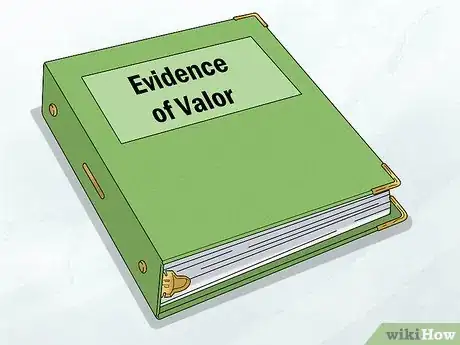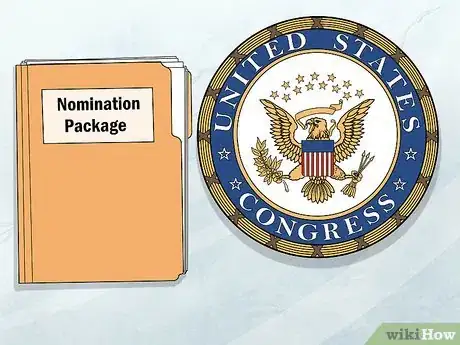This article was co-authored by wikiHow Staff. Our trained team of editors and researchers validate articles for accuracy and comprehensiveness. wikiHow's Content Management Team carefully monitors the work from our editorial staff to ensure that each article is backed by trusted research and meets our high quality standards.
There are 13 references cited in this article, which can be found at the bottom of the page.
This article has been viewed 92,502 times.
Learn more...
The Medal of Honor is the most prestigious award that a person can receive for serving in the Armed Forces of the United States. The Medal is presented to a service member who performed an action demonstrating a distinguishing level of valor. To receive a Medal, you must make it through an extensive nomination and interview process beginning with your commanding officer and ending with the President. It is an extraordinarily rare honor reserved for the very best service members.
Steps
Satisfying the Prerequisites for Nomination
-
1Enlist in a branch of the US Armed Forces. To be eligible to receive the Medal of Honor you must be a member of the U.S. military. The Navy, Air Force, and Army all award medals with unique engravings depicting their particular service branch. The Marine Corps and Coast Guard medals follow the Navy design. Both officers and enlisted men can receive the Medal.
- Women are generally eligible to receive the Medal, although only one woman, Mary Walker in 1861, has had the honor.
-
2Be engaged in military action while in service. In 1963 Congress refined the requirements of the award to specify that a service member must be involved in a military action or conflict in order to be eligible. If you are working alongside “friendly forces,” you are also eligible. This makes the actions taken in more small-scale conflicts recognizable as well.Advertisement
-
3Perform an act worthy of recommendation. To be in contention for a Medal, you must perform a service action that goes above and beyond the norm. It has to be an act of exceptional valor, one that often involves saving the lives of other people and placing yourself in personal peril. Your actions must distinguish you and set you apart from others.[1]
- For example, in February 1945, seventeen-year-old Jack Lucas saved three fellow marines by diving on top of two grenades and lived to receive the Medal. As you can tell from this story, it is best to not search out opportunities to earn acclaim, instead simply serve your fellow service members to the best of your abilities at all times.[2]
-
4Learn more about the medal. If you are a service member interested in receiving the Medal, it is a good idea to find out a little more about its history. This will help you to craft the best possible nomination package. You can go to the Congressional Medal of Honor Society website for lots of good information surrounding the Medal.[3]
- You will find that the total Medal recipients count stands at 3,498 as of December 2016. This number will slowly rise as Presidents present new Medals.
- You may also learn that the Medal was created during the Civil War period and was signed into law by President Lincoln.
-
5Procure substantial evidence of valor. Descriptions and official reports regarding your action will then be grouped together into a nomination package. Some nomination packages are very compressed and contain as few as 50 pages, while others are quite lengthy and grow to well over 1,000.[4]
- You can request that particular persons provide letters of support, however, the initial process often starts without the nominee's direct knowledge. As the investigation continues, official accounts of the action and personal interview responses become important pieces of evidence.
- At any stage in the process, an official can reject or pause your application by citing the lack of evidence regarding the incident in question. For example, in 2003, Air Force Gen. Richard Myers, sent back one application requesting additional eyewitness accounts.[5]
-
6Find contemporaneous descriptions of the incident. Your word alone is not enough evidence. Eyewitnesses, your fellow service members, or higher officials, must also provide numerous and substantial accounts regarding your actions and their importance. Eyewitness statements, in particular, are favored by the award process.[6]
- This requirement, in particular, has presented difficulties for those persons trying to submit a posthumous award application for a deceased service member.
Tracking the Nomination Process
-
1Submit an award nomination via the chain of command. Your statement will most likely begin with your fellow service members writing down sworn statements, which will then be carried on to the unit commander. If your action took place within the past two years, then the paperwork will proceed on upward to its next stop, depending on your service branch. If your action took place more than two years ago, you will need to seek out a congressional nomination.[7]
- For example, Army applications that fit into the two-year window go up to the Army Human Resources Command before being sent even deeper into the chain.[8]
-
2Submit an award nomination via a member of Congress. If more than two years have passed since your action, then your nomination package will need to be sponsored or championed by a member of Congress. This politician’s office will then submit your package to officials within your service branch, such as the Secretary of the Army.[9]
- Relatives of the service member often write letters to politicians requesting that attention be paid to the actions of a particular service member. This is one way to get an application started. The more details that are provided regarding the incident itself, the better.
-
3Prepare for an investigation. Officials will ask the applicant to provide a list of persons who they would like to have contacted as part of the investigation process. This list should include any eyewitnesses to the action as well as character references. Members in the chain of command will also add names to the interview list based upon official reports. The investigation will focus on the incident itself, but also the overall character of the service member in question.
- Many of these interviews will occur face-to-face with questions being repeated multiple times to get an exact timeline and story established. For example, an opening question might be, “How did you learn of this action?” All of these answers will then be compared to official reports.
- These investigations are often made even more challenging by the injuries sustained by the people involved. It is not unknown for investigators to talk with a nominee and their fellow service members in the hospital, if necessary. In some cases, the Medal nominee is medically unable to speak and their actions must be described by others.[10]
- The interview transcripts are then added to the nomination packet and are made available to other individuals in the chain of command as the nomination moves upward.
-
4Watch as your packet moves through the approval process. Your package may be “in play” for two years or more. Throughout this time a series of officials will look over your documents and decide whether or not to pass your package along with an approval, or suggest you for another lower-ranking award. The Distinguished Service Cross is a likely alternative being the second-highest medal awarded for valor.[11]
- For example, if your package moves through Army channels it will need to pass through the: Army Human Resources Command (Army Decoration Board), Manpower and Reserve Affairs, Chief of Staff of the Army, Secretary of the Army, Secretary of Defense, and President. The President has the final say (for all service branches) regarding the approval or disapproval of the nomination.[12]
-
5Anticipate a long wait. Because of the number of offices and individuals involved in the approval process, it is unusual for a nomination package to pass through in fewer than 18 months. You must stay patient throughout this entire time and be available to answer any and all questions. The lengthiness of the process has come under some scrutiny of late, but shows no signs of speeding up.[13]
Making Good Use of the Benefits and Privileges of the Award
-
1Attend the medal ceremony. A press release comes in advance, but this will be your official introduction as a Medal awardee. The President will speak at length about your actions and then will present you with the Medal. If a service member is deceased, their relatives usually receive the award in their place.[14]
-
2Expect local honors. There is a good possibility that your hometown or local area will plan a celebration in your honor. There could be a parade, a presentation of honors, or even a reception at the local school. You should soak up all of this attention while also looking for ways that you can help in the long term.[15]
-
3Bring attention to the heroism of others. As a Medal winner, every time that your story is recounted you will have the opportunity to discuss the valorous actions taken by your fellow service members. Many Medal winners, in particular, choose to highlight the actions of those who lost their lives, especially if those losses took place during the awarded incident.[16]
-
4Serve as a motivational speaker. Some Medal recipients choose to partake in speaking tours. They might travel around to schools or businesses recounting their experiences and providing larger lessons in service. The CMOH website provides a clearinghouse for these opportunities and is one way to match interested organizations with service members.
- Veteran health is a cause close to the hearts of Medal recipients and you can often find them speaking to post-traumatic stress support groups and the like.[17]
-
5Receive certain monetary perks. Your pension coming from the Department of Veterans Affairs will be raised up from the standard amount (depending on the year) and provided monthly. You will also receive at least a 10 percent increase in your general retirement funds. You will have access to free flights on military aircraft and free admittance to various other military facilities (pools, golf courses).[18]
-
6Be saluted by other service members. This is not a hard-and-fast law, but it is suggested that service members should recognize and salute Medal recipients, when possible. The salute can occur whether or not the medal winner is in uniform or wearing their medal. Even higher ranking members are encouraged to offer a salute.
- In addition, Medal recipients are granted uniform privileges and can wear their uniforms as often as they choose.
-
7Be buried at Arlington National Cemetery. Many service members are buried locally when they die. However, Medal recipients have the option, and privilege, of interment at Arlington National Cemetery in Arlington, Virginia, alongside other service members. Due to space limitations, this is an honor offered to only a few people.[19]
- The Department of Veterans Affairs will also provide an engraved headstone for those Medal recipients who have passed away.
Community Q&A
-
QuestionWho would be the first person to nominate someone for MOH?
 Community AnswerUsually a person's fellow service members (their immediate peers) will submit their account to their commanding officer who will then make a recommendation up the chain of command. It is very important that anyone who witnessed the incident firsthand supports the nomination.
Community AnswerUsually a person's fellow service members (their immediate peers) will submit their account to their commanding officer who will then make a recommendation up the chain of command. It is very important that anyone who witnessed the incident firsthand supports the nomination. -
QuestionCan all branches receive the Medal of Honor?
 SpaceshipCommunity AnswerYes, all branches of the United States military can receive the medal of honor.
SpaceshipCommunity AnswerYes, all branches of the United States military can receive the medal of honor.
Warnings
- Be aware that the nomination process for the Medal of Honor is extraordinarily competitive, although the Department of Defense continues to refuse to release exact application statistics.[21]⧼thumbs_response⧽
- You should not make or buy fake versions of the Medal of Honor as you may be breaking the law by doing so. It is also not advisable to pretend to be a Medal of Honor recipient.⧼thumbs_response⧽
References
- ↑ https://gazette.com/military/nominations-decisions-on-medal-of-honor-shrouded-in-secrecy/article_4659feb1-64f4-5a10-a3e8-9cdf7fa9e0e7.html
- ↑ http://articles.latimes.com/2008/jun/06/local/me-lucas6
- ↑ https://www.cmohs.org/
- ↑ https://gazette.com/military/nominations-decisions-on-medal-of-honor-shrouded-in-secrecy/article_4659feb1-64f4-5a10-a3e8-9cdf7fa9e0e7.html
- ↑ https://www.washingtonpost.com/news/checkpoint/wp/2015/06/01/it-took-97-years-to-get-these-soldiers-the-medal-of-honor-heres-how-it-happened/?utm_term=.51456c90b17d
- ↑ http://www.nytimes.com/2015/06/03/us/two-world-war-i-soldiers-to-posthumously-receive-medal-of-honor.html?_r=0
- ↑ http://edition.cnn.com/2010/US/11/16/medal.of.honor.giunta.process/
- ↑ https://www.army.mil/medalofhonor/process.html
- ↑ https://www.army.mil/medalofhonor/process.html
- ↑ http://www.cbsnews.com/news/obama-awards-medal-of-honor-to-marine-kyle-carpenter/
- ↑ http://edition.cnn.com/2010/US/11/16/medal.of.honor.giunta.process/
- ↑ https://www.army.mil/medalofhonor/process.html
- ↑ https://www.army.mil/medalofhonor/process.html
- ↑ http://www.nytimes.com/2015/06/03/us/two-world-war-i-soldiers-to-posthumously-receive-medal-of-honor.html?_r=0
- ↑ https://www.stripes.com/news/navy/navy-seal-to-receive-medal-of-honor-monday-tells-his-story-1.396290
- ↑ https://www.stripes.com/news/navy/navy-seal-to-receive-medal-of-honor-monday-tells-his-story-1.396290
- ↑ http://www.marines.mil/News/News-Display/Article/910015/medal-of-honor-recipient-implores-let-it-out/
- ↑ http://edition.cnn.com/2010/US/11/12/medal.of.honor.perks/
- ↑ http://www.military.com/benefits/veteran-benefits/the-medal-of-honor.html
- ↑ http://www.nbcnews.com/news/military/mary-edwards-walker-only-woman-receive-medal-honor-n111596
- ↑ https://gazette.com/military/nominations-decisions-on-medal-of-honor-shrouded-in-secrecy/article_4659feb1-64f4-5a10-a3e8-9cdf7fa9e0e7.html
About This Article
To receive a Congressional Medal of Honor, you must enlist in a branch of the U.S. Armed Forces and be engaged in military action. During your service, serve your fellow service members to the best of your ability. You’ll be more likely to receive a Medal of Honor if you receive other awards during your service, like Bronze Stars, Combat Action Ribbons, and Purple Hearts. Most Medal of Honor nominees are nominated by others, but if you like, you can build a nomination package yourself, consisting of eyewitness accounts of your heroic actions. Keep reading to learn more about the nomination process, including the interview and the approval process.



























-Step-10-Version-3.webp)

















































